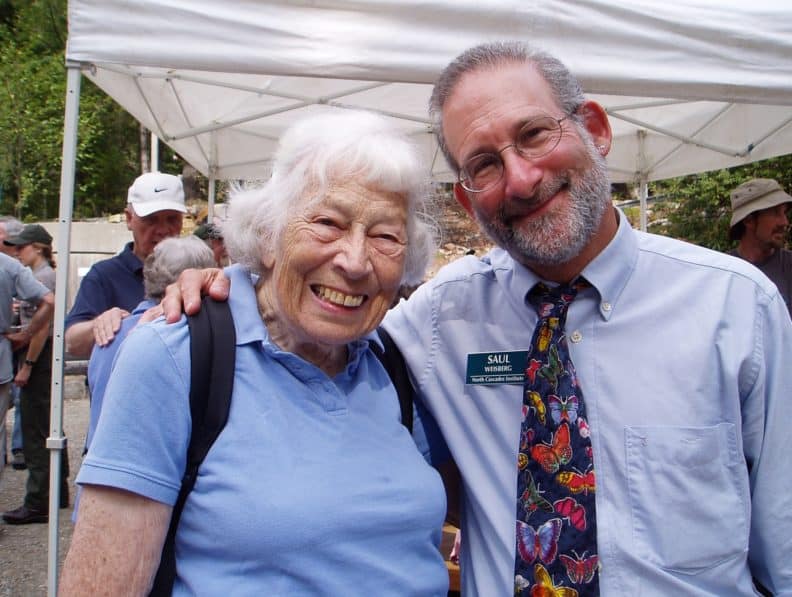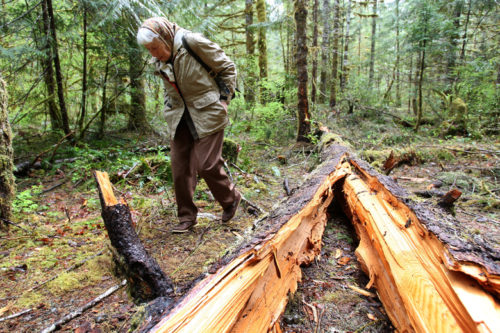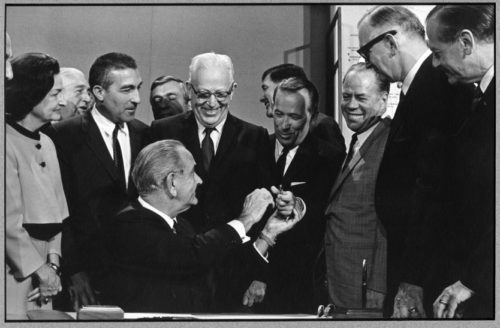
Polly Dyer: NW conservation hero passes away at age 96
In the North Cascades, a mosaic of public lands—national, state, and provincial parks, national forests, wilderness and recreation areas—protects many of the region’s most beloved areas. It’s easy to take their stewardship for granted—few today would argue against preserving natural treasures like Mount Baker, the Picket Range, Cascade Pass, and Suiattle River—but in truth, Washingtonians owe a great deal of gratitude to early visionaries like Polly Dyer.
Without Dyer and her ilk, imagine what might have been: Clear-cuts in the Stehekin Valley. A half-mile-wide open-pit copper mine in the shadow of Glacier Peak. The ancient cedars of the Little Beaver Valley drowned underwater. And elsewhere in the state, a ski area, tramway, and golf course on Mount Rainier; the Hoh River valley excised from Olympic National Park and sold for timber. Instead of the most primitive stretch of coastline in the Lower 48, a scenic highway running along the beaches from La Push to Shi Shi.
Dyer’s six decades of writing letters, organizing volunteers, attending meetings, serving on committees, and lobbying legislators in both Washingtons have helped keep some of our most spectacular landscapes intact. And in the era before social media, virtual meet-ups, and online petitions, those conservation efforts required a lot of legwork, fundraising, face-to-face negotiations, and pots of coffee.
Born in Honolulu in 1920, Pauline Dyer saw a wide swath of America as her father moved around the country following Coast Guard postings: Seattle, New York City, Connecticut, Philadelphia, Baltimore, Florida, and finally, Alaska. Summers at Girl Scout camp introduced her to the natural world, but the raw wilderness of Alaska provided what she later called:
The basis for my whole life since.”
She met her husband, John, on the trail, and together they explored coastal areas like Glacier Bay in a sixteen-foot skiff, reading John Muir to pass the time. They moved to Berkeley, hiking the Sierra Nevada and becoming active in the Sierra Club, before finally settling down in the Seattle area in 1950, where the Cascades to the east and Olympics to the west fueled their passion for hiking, climbing, and conservation. Polly joined The Mountaineers and chaired the club’s Conservation Committee; established the Pacific Northwest Chapter of the Sierra Club, the first chapter outside of California; helped lead the Olympic Park Associates; and cofounded the North Cascades Conservation Council.
Preserving wild places has been Dyer’s undying passion.
It is a priceless asset which all the dollars man can accumulate will not buy back,”
She testified before the US Senate, in support of what would become the Wilderness Act of 1964. With fellow conservationist Howard Zahniser, she is credited with the elegant definition of wilderness enshrined in that legislation:
…an area where the earth and its community of life are untrammeled by man, where man himself is a visitor who does not remain.”
Discussing her innate love of wilderness, Dyer exclaims that nature brought her
almost unbounded joy. I wanted to stretch out my arms and bring it all up close to me. I felt that it was literally a part of me.”
As environmental conservation slowly took hold in the national consciousness in the 1960s, all eyes looked toward the North Cascades. The Sierra Club, Wilderness Society, The Mountaineers, and countless local groups were determined to win permanent protection for the “American Alps.” The North Cascades Conservation Council had been formed in 1957 by Dyer, Phil Zalesky (a Seattle high school teacher), Patrick Goldsworthy (a University of Washington biochemist), and others to push the effort forward, and their goal took years of political maneuvering, pamphleteering, petitioning, and letters to the editor. Their most canny strategy may have been leading VIPs and common citizens on hikes to see for themselves what made these mountains, valleys, and forests unlike any others in America.

President Johnson preparing to sign the Enabling Legislation for North Cascades National Park Complex
President Lyndon Johnson signed the North Cascades Act in 1968, creating North Cascades National Park, Ross Lake National Recreation Area, Lake Chelan National Recreation Area, and nearly one million acres of wilderness in the neighboring Glacier Peak and Pasayten highlands.
Dyer’s drive has been to protect wilderness areas, preserving them as places where the force of nature—rather than the will of human beings—prevails … Banding with others who fervently believe protecting wilderness areas matters, and steadily recruiting new supporters for the conservation movement, has been her life’s work.”
— Paula Becker, historian

